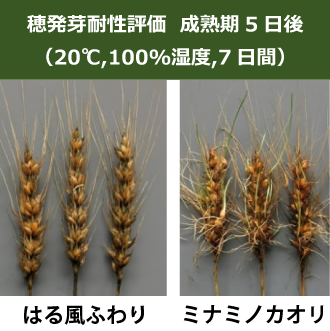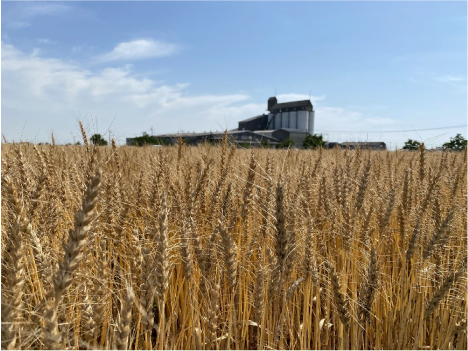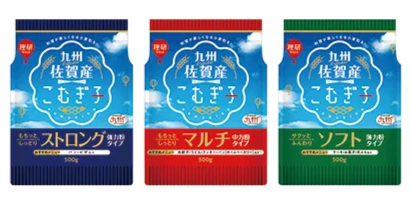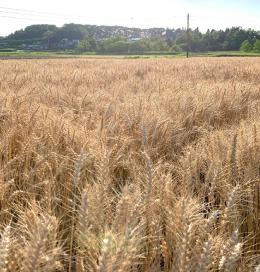(This is an English translation of the original Japanese article.
The publication date refers to that of the Japanese version,
which differs from the upload date of the English version.)
Wheat often suffers from pre-harvest sprouting (※1) and a decline in quality when it rains during the harvest season, causing problems for producers and users. However, in Japan, mainly in Honshu island, the wheat harvest season often falls on the rainy season. Therefore, there has been a desire to have wheat varieties resistant to pre-harvest sprouting in order to stabilize the quality.
In this context, two varieties with such characteristics, "Harukaze-fuwari" and "Harumizuki," were developed in 2018 and have been widely used. Harukaze-fuwari is excellent for bread making and has been adopted as a recommended variety (※2) in Saga Prefecture. Harumizuki is suitable for bread and soy sauce brewing and has been adopted as a certified variety (※3) in Oita Prefecture. Both varieties are expected to continue their expansion in the future.
Preventing loss of commercial value due to pre-harvest sprouting
In western Japan, the wheat variety "Minamino-kaori" has been mainly cultivated for bread making. Minamino-kaori has a late maturity timing and is prone to pre-harvest sprouting (Photo 1), so when the harvest season coincides with the rainy season and has a lot of rain, its quality declines significantly due to pre-harvest sprouting. Wheat that sprouted or reached the pre-sprouting stage undergoes degradation of starch and protein in the seeds, resulting in a decline in bread-making suitability, such as bread not rising during processing. This causes the grade (※4) and quality rank (※5) decrease.
For this reason, as the desired wheat varieties that are more suitable for bread making with their early maturity timing and resistance to pre-harvest sprouting, the Kyushu Okinawa Agricultural Research Center of the National Agriculture and Food Research Organization (NARO) developed Harukaze-fuwari, and the Western Region Agricultural Research Center of NARO developed Harumizuki in 2018. Both varieties have been promoted as the cultivars that can be grown stably.
 |
| Photo 1: Comparison of pre-harvest sprouting resistance between Harukaze-fuwari (left) and Minamino-kaori (right). Harukaze-fuwari is more difficult to sprout (provided by Saga Prefectural Agriculture Research Center) |
Harukaze-fuwari widely used for bread in Saga Prefecture
Saga Prefecture is the third largest wheat producer in Japan, following Hokkaido and Fukuoka Prefectures. A new variety Harukaze-fuwari (Photo 2) was adopted as a recommended variety of the Prefecture in 2021 and has been promoted there. The cultivation area and production volume have increased about 20 times in three years: 51 ha and 190 t in 2020, 432 ha and 1,958 t in 2021, and 1,011 ha and 4,553 t (expected) in 2022. Technical guidance using a cultivation manual prepared by the Saga Prefectural Agriculture Research Center is also being conducted. The harvest scene was broadcasted on TV in June 2022, and the awareness of Harukaze-fuwari is increasing. The name Harukaze-fuwari ("spring breeze blowing softly" in Japanese) also evokes the fluffiness of freshly baked bread.
 |
| Photo 2: Harukaze-fuwari during the harvest season (provided by Saga Prefectural Agriculture Research Center) |
Highly evaluated for its suitability for bread making
In the sensory evaluation of the bread-making test, where "No.1 Canada Western Red Spring Wheat (1CW)" (※6), which is said to be the highest quality wheat for bread in the world, is rated at 80 points, Harukaze-fuwari received a high score of 81.4 points. The bread is plump, soft, and has a moderate chewy and moist texture.
In 2021, Riken Nosan-Kako Co., Ltd. (Saga City) released "Kyushu Saga Komugiko" (Photo 3), a three-lineup series of household flour that contains Harukaze-fuwari. This series of flour is made from wheat 100% harvested in Saga Prefecture and each lineup is for cake, all-purpose, and bread respectively. The company aims to sell the flour that is 100% made from "Harukaze-fuwari" in the future.
 |
| Photo 3: Flour products using Harukaze-fuwari (provided by Riken Nosan-Kako Co., Ltd.) |
Harumizuki became popular for soy sauce brewing
The new variety Harumizuki (Photo 4) was adopted as a certified variety in Oita Prefecture in 2019 and is rapidly increasing its cultivation area. In the fall of 2020, its cultivation began on about 390 ha, and this year (2022), the sowing area is expected to expand to about 1,060ha. Compared to conventional varieties such as Nishinokaori and Minaminokaori, Harumizuki is not only less likely to sprout before harvest, but also can be harvested earlier, making it easier to avoid the risk of losing yield and quality due to the rainy season. It also has excellent yield and lodging resistance. Oita Prefecture is well-known for its soy sauce brewing. Roasted and crushed wheat is used in soy sauce brewing to produce a fragrant flavor.
Harumizuki has been used for soy sauce brewing since 2021, but it will also be used for bread from the 2023 crop. With the local promotion of Harumizuki in Oita Prefecture as an opportunity, producers and users are working together to upgrade cultivation technology throughout the area, and expectations are high that it will become a brand product of Oita Prefecture in the future.
 |
| Photo 4: Harumizuki near harvest (provided by Oita Prefectural Agriculture, Forestry and Fisheries Research Center) |
Glossary
※1 Pre-harvest sprouting: The phenomenon of seeds germinating while still attached to the ear before harvest.
※2 Recommended varieties: Excellent and approved by each prefecture for widespread adoption within the prefecture. May also be referred to as superior varieties.
※3 Certified varieties: Recognized by each prefecture as necessary for cultivation in response to specific regional or demand needs. May also be referred to as superior varieties.
※4 Grade: Divided into first, second, and non-standard based on the appearance such as grain properties.
※5 Rank: Divided into four categories, A to D, based primarily on components and quality such as protein content.
※6 1CW: Abbreviation for No.1 Canada Western Red Spring, a brand of bread wheat imported from Canada. "No.1" represents the highest grade.
Project name
Research Program on Development of Innovative Technology(Development Research Stage)
Project period
FY2016 to 2020
Title
Development of Wheat Varieties for Bread-making in Warm and Temperate Regions with Processing Suitability and Cultivation Characteristics that Meet the Needs of Users
Leading research institutes
Kyushu Okinawa Agricultural Research Center of the National Agriculture and Food Research Organization (NARO), Western Region Agricultural Research Center of the National Agriculture and Food Research Organization (NARO), Saga Prefectural Agriculture Research Center
